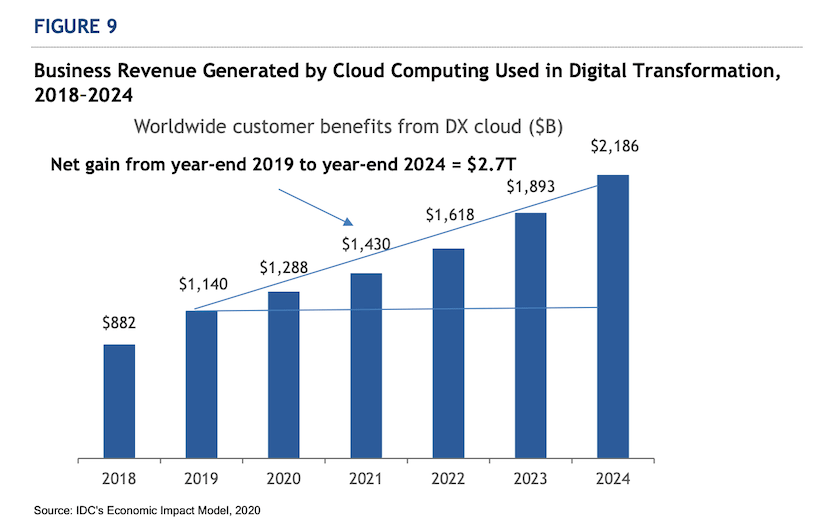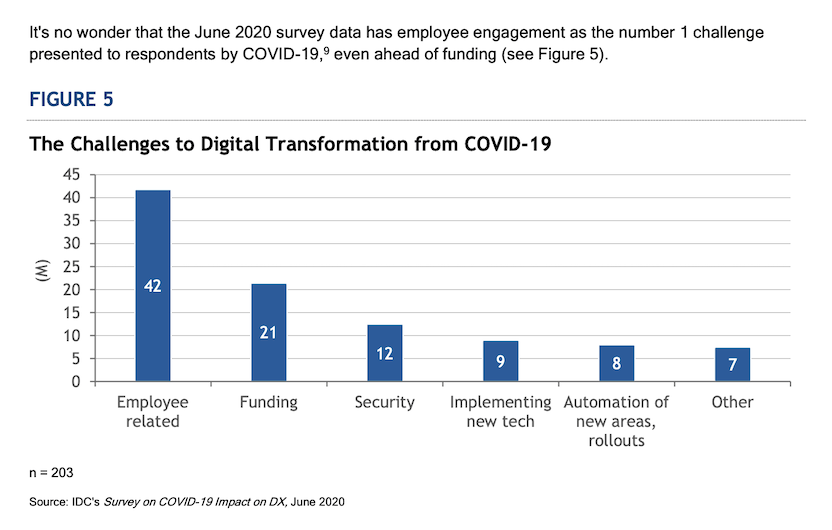Creative Cubes, a coworking space in Melbourne, Australia, condensed a six-month integration roadmap into six-weeks to attract commercial real estate clients in an unlikely market.
“We found that we had created an internal fragmentation where we had multiple business units serving members of our community in different ways, but none of those systems actually spoke to one another,” said Tobi Skovron, chief operations officer of Creative Cubes.
Skovon is just one of 200 executives we spoke to in a recent whitepaper study conducted by IDC, sponsored by Salesforce, to uncover how COVID is impacting digital transformation across C-suites. While we would have assumed executives are concerned about speed to value, we discovered they’re focused on cloud investments to prioritize integrated customer touch points. They’ve found the missing ingredient. And they’re moving to digital faster than before.
The golden standard for digital transformation is now a matter of urgency, forcing us to reimagine brand experiences for both customers and employees. Transformation is now a digital imperative — and an ongoing evolution toward customer-centricity. If you want to change results, you have to change your approach, and that requires having insight into what business leaders are doing differently.
We’ve identified three strategies organizations can use to quickly activate digital transformation.
Decide what will help you quickly digitally transform
Tony Robbins said it best: “Complexity is the enemy of execution.” It’s safe to say this rings true for every roadmap to digital transformation. It’s laced with complexities, change management, and all the intricacies of a merger acquisition. Yet now more than ever, going digital provides a greater opportunity to strengthen relationships with customers. So, where are leading organizations simplifying their approach?
IDC’s survey found that companies succeeding with digital transformation made cloud computing the highest priority area for crisis response, with the number one priority being integrated customer touchpoints. In fact, more than half the executives surveyed (55%) predicted the COVID-19 pandemic would increase their spending on cloud computing.
Cloud software, like CRM, allows a company to connect its teams on a shared, work-from-anywhere system with a unified view of its customers so that employees can engage customers across every touchpoint.

“I wouldn’t say that COVID-19 changed what we were doing so much as how quickly we were doing it”, said Morgan Griffith, vice president of digital strategy and transformation for Bon Secours Mercy Health. “We had already kicked off a road map to develop an enterprise-wide closed-loop patient access and engagement platform, and having this plan in place allowed us to accelerate our virtual offerings, and tighter integration of our web portal and website tools for consumers,” she adds.
At the peak of uncertainty, Bon Secours Mercy Health managed to ramp up from a 50–200 virtual patient visits a day to more than 8,000 through the use of cloud technology like Customer 360.
Expect challenges and find solutions with technology
Most of the executives who participated in the IDC survey said the “single biggest challenge” presented by COVID-19 related to employees. Standard onboarding and training quickly became a myriad of new operations. On the contrary, the subcomponents such as security and automation in Figure 5 of the whitepaper indicate employee-related challenges won’t go away without the right technology in place. These pervasive challenges have inspired us to create solutions to help companies create safe and resilient workplaces.

A key component of achieving success with digital transformation is a focus on integration. The average enterprise has 900 applications and less than 30% of them are integrated — a huge challenge for unifying data to support evolving customer needs.
Pack Health solved for these challenges when its leadership realized early on that COVID-19 would lead to greater demand for remote healthcare. The company proactively hired additional staff and gave them laptops prepopulated with Service Cloud. Pack Health was able to move its health advisor training system online, which was previously a mix of in-person and online sessions, to quickly prepare new staff to engage with members.
Pilot digital around value-added services
This has been a hallmark year for piloting new services, and many organizations have met their goals with digital transformation. Respondents mentioned in IDC’s survey that developing value-added services that offer new mobile or remote-access facilities was a priority.
For example, Fruit Street Health, a six-year-old physician-funded telehealth start-up based in New York City, decided to develop a new product, CovidMD, which would allow a member of the public to take a risk assessment online, video chat with a doctor, get referred to a doctor in their state, and schedule appointments.
“We needed a scalable solution where if we had to enroll, say, 10,000 doctors and 10 million patients, it wouldn’t crash. We didn’t want to have to deal with a major DevOps [development operations] situation,” says Laurence Girard, CEO. “Using Salesforce cloud services allowed us to accomplish building CovidMD in 60 days rather than a year or more.”
We needed a scalable solution where if we had to enroll, say, 10,000 doctors and 10 million patients, it wouldn’t crash. We didn’t want to have to deal with a major DevOps [development operations] situation,” says Laurence Girard, CEO. “Using Salesforce cloud services allowed us to accomplish building CovidMD in 60 days rather than a year or more.
In another example, PepTalkHer, a professional services company helping Fortune 1000 companies recruit, retain, and engage talent, hit a major wall at the onset of the pandemic. Its consumer business, which consisted of brand partnership and events, disappeared. And as the physical world paused, payments got delayed and the sales pipeline evaporated.
“We got new work because we pivoted and created a virtual offering,” said Meggie Palmer, founder and CEO.
By offering online versions of previously in-person events, made possible by the use of Salesforce cloud services and other tools, the company managed to book new business. Cloud-based tools allowed them to quicken the sales process, capture leads coming in from the web in a CRM system, automate manual procedures, centralize client responses, and schedule client emails.
Digital transformation and cloud-based technologies are critically important as organizations respond to ongoing disruption and new business imperatives. Cloud-based platforms offer organizations a cost-effective way to integrate customer touchpoints, improve workflows, achieve productivity and efficiency gains, and respond to new business challenges as they arise.
How to solve for challenges toward digital transformation
Gaining stakeholder buy-in
Solution: Propose short-term budget allocations and closely track and communicate quick wins.
Integrating across multiple cloud platforms
Solution: Assess integration strategy to prioritize customer and employee engagement, but also consider how to create a leaner, easily-integrated tech stack in the future.
Ensuring strong security
Solution: Prioritize key security concerns to solve for and opt for solutions that include multi-factor authentication, transport layer security, etc.
Revamping employee workflows
Solution: Audit where workflow and process bottlenecks cause friction and seek tech solutions designed to bridge silos and unite teams around the customer.
Read The Impact of Digital Transformation During Times of Change
Read the IDC whitepaper to learn what executives are doing differently this year to accelerate their digital transformation.








![[Illustration] A service rep delivers proactive customer service](https://www.salesforce.com/blog/wp-content/uploads/sites/2/2024/11/proactive-customer-service-1500x844_60k.jpg?w=128&h=96&crop=1&quality=75)






















